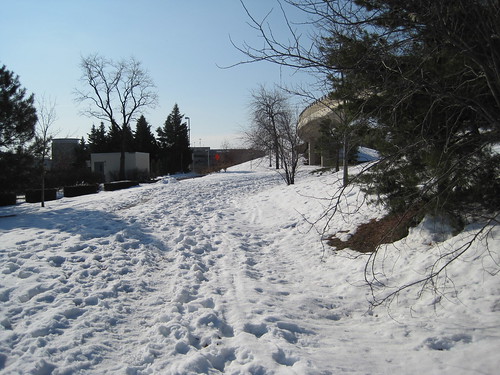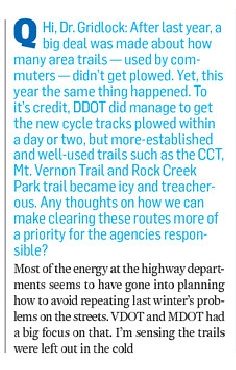Yesterday's DC Rider column in the
Express ran a question from a reader about the failure to remove snow from the Mount Vernon Trail and the Capital Crescent multi-user trails, but did mention that in DC, DC's Dept. of Transportation is removing snow from cycle tracks and the Metropolitan Branch Trail.
The response was about Departments of Transportation in Virginia and Maryland overlooking the trails.
The response missed the point entirely.
The problem with snow removal on trails is that for the most part, trails are located in parks, and parks are run by the National Park Service and/or local parks departments. (Other places don't have to worry about the NPS, but transportation access to trails in State Parks tend to be an issue as well.)
Parks departments aren't transportation departments.
They think about trails in terms of recreation.
So a snow covered trail becomes a good opportunity to do things other than bicycle, such as cross-country skiing.
 Flickr photo of the Crystal City spur after the GW Parkway underpass, February 21st, 2010
Flickr photo of the Crystal City spur after the GW Parkway underpass, February 21st, 2010 by darbofumi.
Not about trails as transportation infrastructure that therefore needs to be maintained in a variety of weather conditions--including snow--to support the users.
Somehow--I don't claim to have the answer on how--parks departments need to understand that their mission must expand with regard to snow removal from multi-user trails used for transportation.
Maybe that means working with local transportation departments to develop "memoranda of understanding" to share services to address the issue.
Many of the region's master plans for Park and Recreation Departments and for Bicycling tend not to address these two issues:
(1) park infrastructure used for transportation;
(2) maintaining park infrastructure for transportation in all seasons and weather conditions.
and bike master plans (and pedestrian plans for that matter) tend not to address:
(3) maintaining infrastructure in all seasons and conditions.
Obviously that needs to change. And columnists--not just transportation writers--for local newspapers ought to expand their knowledge base so that they know what the issues are and write about them accurately.
-------
Note that I made recommendations about snow removal and transportational use of infrastructure located in parks and under the jurisdiction of the County Parks Department in the Western Baltimore County Pedestrian and Bicycle Access Plan.
There it's a bit different, because some parks and trails are in areas defined as rural (although this is tricky because the Patapsco Valley State Park is defined as rural, but it abuts urban areas of the county and the Grist Mill Trail is used by bicycle commuters). What I recommended is that for trails in parks in the urban county, snow removal plans should be developed, and that for trails in parks in the rural county, they wouldn't be targeted for snow removal.
Note that even Harford County, Maryland does snow removal on what they thought was a strictly recreational trail, the Ma & Pa Railroad Trail, because of requests from residents.
Labels: bicycling, provision of public services, snow removal, transportation planning





0 Comments:
Post a Comment
<< Home